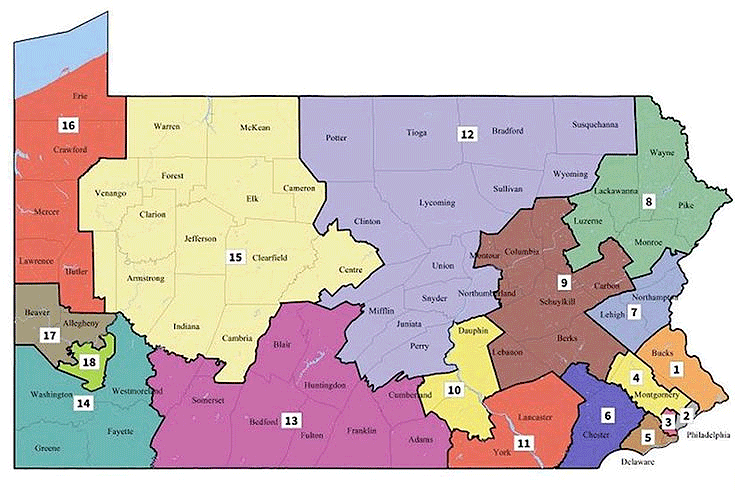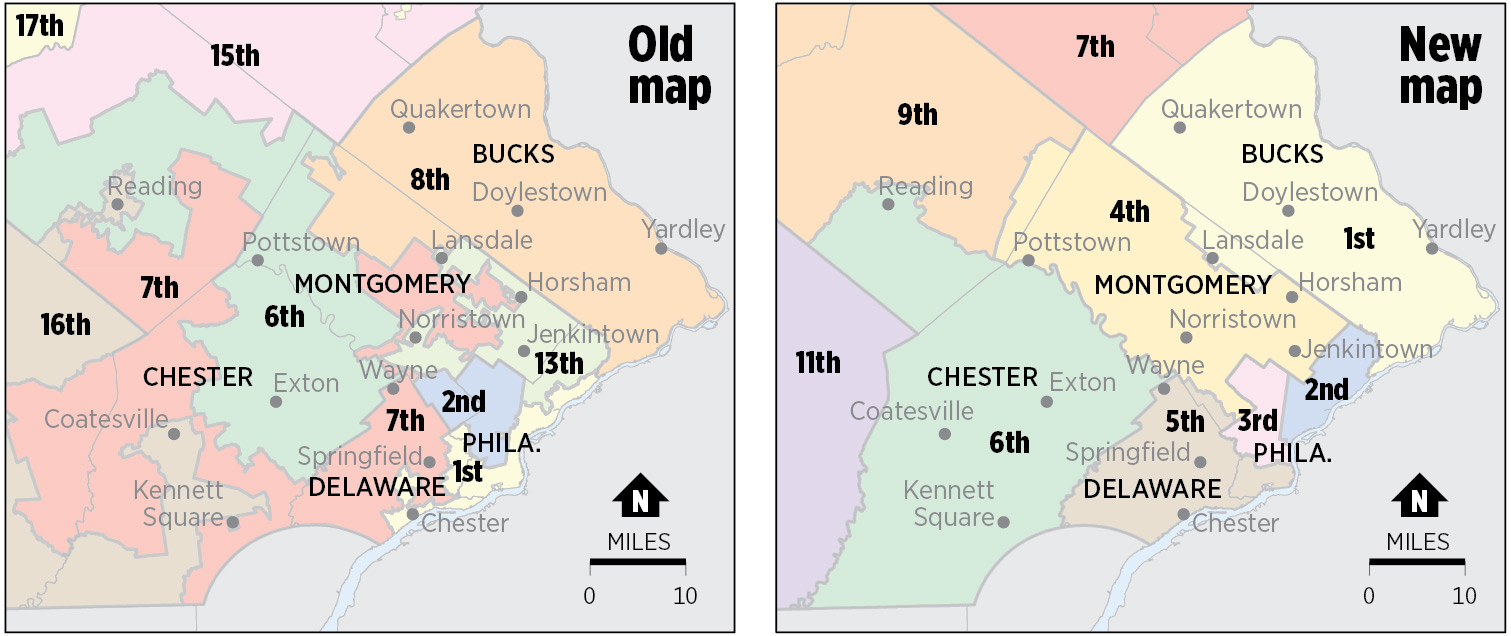By Jim Ellis
Feb. 21, 2018 — The Pennsylvania Supreme Court placed into law a new congressional map Monday, thereby completing their assumption of legislative redistricting duties, and with it bringing questions pertaining to institutional balance of powers.
The map is a radical reconfiguration of the Pennsylvania plan that has been in place since the 2012 election. The re-draw even went so far as to re-number virtually all of the districts, thus changing the state’s historical political complexion. It is probable that Republicans will file a new lawsuit against this map in federal court, with the goal of getting it to the US Supreme Court. The high court has stayed similar recent redistricting decisions in Michigan, North Carolina, and Texas in anticipation of the Wisconsin political gerrymandering decision, so it is possible the same could happen here.
Comparing the new districts to the current map, President Trump carried 12 of the state’s 18 CDs under the previous congressional plan, though Republicans hold 13 of the 18 districts in the US House. Under the new plan, President Trump would have won 10 of the 18 districts.
The Daily Kos Elections political analysis site released political and geographic data for the new 18 districts. It is probable that Democrats would gain three to five seats under this new plan. A summary of their findings follows:
District 1 (Former District 8): Rep. Brian Fitzpatrick (R-Levittown) will keep 93 percent of his current district, adding bits from Reps. Brendan Boyle’s 13th (D-Philadelphia) and Pat Meehan’s (R-Chadds Ford) 7th District. Together, the politically marginal seat becomes two points more Democratic, meaning that Rep. Fitzpatrick could be facing a toss-up re-election if this map stands. President Trump carried the former 8th District by the barest of margins, 48.2–48.0 percent. The new 1st District would have gone to Hillary Clinton, 49.1–47.1 percent.
District 2 (Former District 1 and 13): It appears that Rep. Boyle will have his choice of districts as his former 13th District is split almost evenly between new District 2, which is more of a Philadelphia city district, and District 4, which is the Montgomery County suburban seat. If Rep. Bob Brady (D-Philadelphia) were seeking re-election, he would likely run here. But Boyle will have his choice of Democratic districts. The new 2nd would have voted for Hillary Clinton in a 73-25 percent margin.
District 3 (Former District 2): The new 3rd appears to be the seat where freshman Rep. Dwight Evans (D-Philadelphia) will seek re-election. The altered configuration contains 80 percent of the congressman’s previous district and voted 91-7 percent in favor of Hillary Clinton.
District 4 (Parts of Districts 13, 6, 7, 8 and 2): The new Montgomery County-anchored 4th District will likely become an open Democratic seat. Rep. Boyle could run here because this seat has a plurality of territory from his current 13th CD (43.5 percent), but he would likely opt for the new District 2. The new 4th also contains territory from Rep. Ryan Costello’s (R-West Chester) 6th District (26.7 percent), Meehan’s 7th CD (18.8 percent), and slivers from Reps. Fitzpatrick’s 8th, and Rep. Evans’ 2nd. This new configuration would have voted for Hillary Clinton in a 58-38 percent margin spread.
District 5 (Parts of former Districts 7 and 1): Rep. Meehan deciding to retire from the House allowed the court to easily eviscerate his 7th District. About 54 percent of his previous territory winds up in this new 5th District, with another 40 percent coming from Rep. Brady’s PA-1. This seat will become open and designed to elect a new Democrat. Hillar Clinton would have racked up a 63-34 percent victory under this district configuration.
District 6 (Remains District 6): Rep. Costello keeps half of his current constituency and gains territory from fellow Republicans Lloyd Smucker (R-Lancaster) and Meehan. But he largely gets Democratic territory from each of those neighboring districts. Though Clinton carried the former 6th District, 48.2 – 47.6 percent, the new 6th would have yielded her winning, 53-43 percent. Therefore, Costello will face a very difficult re-election fight.
District 7 (Former District 15): Retiring Rep. Charlie Dent’s (R-Allentown) Lehigh Valley district is re-numbered 7, but it contains 72 percent of the previous territory. Adding all of the city of Bethlehem and annexing Democratic Easton takes the seat from comfortably Republican to a virtually even split between the two parties. The previous 15th District went for President Trump, 52-44 percent. The new 7th would have gone for Hillary Clinton, 49-48 percent. This will likely be a toss-up open-seat campaign.
District 8 (Parts of former Districts 17, 10, and 11): Rep. Matt Cartwright (D-Moosic) sees his current seat being split apart. He would likely seek re-election in the new 8th District, which contains his Scranton area political base. The new 8th retains about 48 percent of Cartwright’s current constituency, and remains a 53-43 percent Trump domain. The fact that 52 percent of the new district comes from the Republican districts of Reps. Tom Marino (R-Williamsport) and Lou Barletta (R-Hazelton) suggests that this seat could become competitive in the general election. Clearly, Cartwright is the one sitting Democratic incumbent who fares worse under this map.
District 9 (Parts of former Districts 17, 11, 6, 15, 7, and 16): The new 9th is likely the place where Rep. Barletta would have run for re-election if he were not in the Senate race. This is the other district where Rep. Cartwright could run because 28 percent of his constituency was sent here; however, with a 65-31 percent Donald Trump win within the new configuration, his victory chances would be very poor. Since 22 percent of Rep. Costello’s 6th District has been placed here, the new 9th could potentially become a landing spot for him even though none of his anchor political base would be included.
District 10 (Former District 4): Almost 60 percent of Rep. Scott Perry’s (R-Dillsburg/ York) comprises new District 10, which becomes the Harrisburg-York district. Democrats gain about six points in comparison to former District 4, but the new 10th would have voted 52-43 percent for President Trump.
District 11 (Former District 16): Freshman Rep. Smucker sees his new district increase his Republican voting base by almost a net 20 percentage points. Keeping two-thirds of his current Lancaster-anchored district intact, Smucker now sees his district going to 61-35 percent Trump.
District 12 (Former District 10): Rep. Marino gets a new expansive northern Pennsylvania seat that includes two-thirds of his former constituency. His 66-30 percent former Trump victory percentage remains virtually the same in the new 12th.
District 13 (Parts of former District 9, 12, 4, 11, 5, and 18): If Rep. Bill Shuster (R-Hollidaysburg/Altoona) were seeking re-election, he would run here since 53 percent of his constituency now resides in this CD. Already a strong Republican region, this new configuration takes the Trump percentage to 71-26 percent. This seat will feature a competitive open Republican primary, but the winner holds the new district in the general election.
District 14 (Parts of former Districts 18, 9, 12, and 14): With 57 percent of the former 18th District becoming part of new District 14, the March 13 special election winner will immediately find himself with a new half of a district. The draw is bad news for special election Democratic nominee Conor Lamb. Should he score an unlikely upset in the special, he would face running in a new district that would be five points more Republican than the current 18th. The new 14th went for President Trump, 63-34 percent.
If special election Republican nominee Rick Saccone wins on March 13, he will seek re-election in this new seat, which should be even more favorable for him. The problem both men would have, however, is they will still have to compete in the old district on March 13, but they immediately turn around and engage in a primary election in the new PA-14 on May 15. This could cause Saccone, in particular, significant logistical problems since 43 percent of the new 14th is not included in the current District 18 and more Republicans would be likely to file in CD-14 primary because of its favorability to a GOP candidate.
District 15 (Parts of former District 5, 9, 3, and 12): Most of Rep. Glenn Thompson’s (R-Howard) rural north Pennsylvania district (57 percent) is included in new District 15. He would have little trouble in a general election, but might find himself vulnerable in a GOP primary. President Trump carried the new 15th, 70-27 percent.
District 16 (Former District 3): Rep. Mike Kelly (R-Butler/Erie) would keep 80 percent of his constituency intact, and would have little trouble seeking re-election. His seat becomes a net six percent more Democratic, but the Trump margin was still a solid 58-38 percent.
District 17 (Parts of former Districts 12, 14, 18, and 3): Rep. Keith Rothfus (R-Sewickley) is another Republican incumbent who finds himself in a more difficult political situation. He keeps 56 percent of his current constituency, but inherits over 21 percent from Rep. Mike Doyle’s (D-Pittsburgh) Democratic CD. This takes Rothfus’ Republican percentage down to 49-47 percent Trump, a net 19 percentage point move in the Democrats’ favor.
District 18 (Former District 14): Rep. Doyle keeps 76 percent of his Pittsburgh-anchored district, and will have little trouble winning re-election despite the district becoming a net 10 points more Republican.


